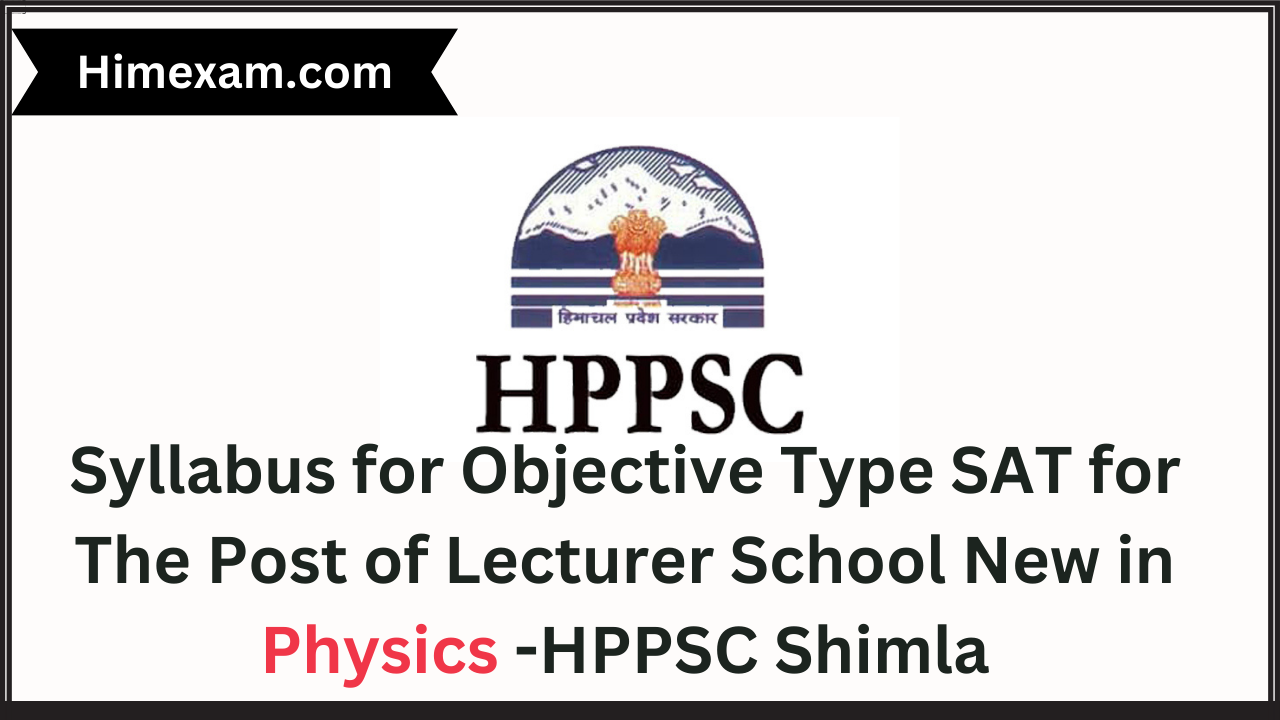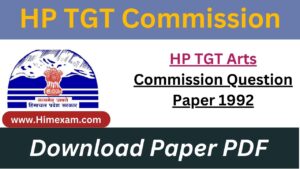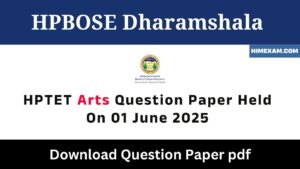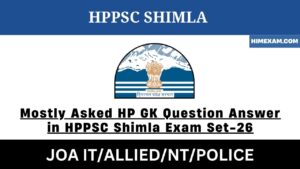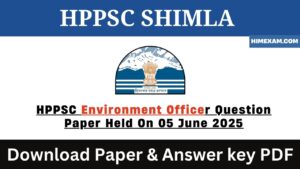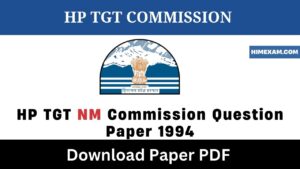Syllabus for Objective Type SAT for The Post of Lecturer School New in Physics-HPPSC Shimla
COMMON SYLLABUS FOR OBJECTIVE TYPE SUBJECT APTITUDE TEST (SAT) FOR RECRUITMENT TO POST OF LECTURER (SCHOOL NEW) IN PHYSICS, CLASS-III IN THE DEPARTMENT OF HIGHER EDUCATION. THIS PAPER WILL BE OF 02 HOURS DURATION OF 100 MARKS. THE OBJECTIVE TYPE SUBJECT APTITUDE TEST (SAT) SHALL COVER FOLLOWING TOPICS:
Syllabus for Objective Type SAT for The Post of Lecturer School New in Physics -HPPSC Shimla
PART-I (Subject) 80 marks
1.Mathematical Physics: Complex Variables: Analyticity of the function of a complex variable, Cauchy integral theorem and formula. Expansion of an analytic function; Taylor and Laurent series. Residue theorem, contour integration, Jordan Lemma. Applications in evaluation of definite integrals. Dispersion relation, saddle point method, Vector Spaces: Vector Spaces and Matrices; linear independence, bases; dimensionality; inner product; linear transformations. Matrices; Inverse; Orthogonal and Unitary matrices; Independent elements of a matrix; Eigen-values and eigen-vectors; Diagonalization; Complete orthonormal set of functions, Special and Orthogonal Functions: Partial differential equations, separation of variable technique in Cartesian, Spherical, Cylindrical Coordinates. Special functions related to these equations (Laguerre, Bessel’s, Legendre and Hermite) and their applications to boundary value problems, Sturm- Liouville theory and orthonormal eigen-functions. Beta and Gamma functions. Fourier and Laplace transforms and their properties. Applications of Laplace Transforms to solve differential equations, Green’s Function: Non homogeneous boundary value problems and Green’s functions in one dimension. Eigen-function expansion of Green’s function. Fourier transform method of constructing the Green’s function, Green’s function in 3-dimensions, application to scattering problem.
2. Classical Mechanics: Mechanics of a system of particles, Constraints, Classification of Constraints, Generalized Coordinates, Virtual displacement and principle of virtual work, D’Alembert Principle, Lagrange’s Equations, Generalized momenta, Cyclic Co-ordinates, Conservation Laws. Calculus of variation- Euler- Lagrange Equation, Application of Variational Principle, Shortest distance problem, brachistrochrone, Geodesics of a Sphere, Variation under constraintsLagrange’s multipliers, Hamilton’s principle, Lagrange’s equations from Hamilton’s principle, Problems based on Lagrange’s equations, Principle of least action. Hamilton’s equations and Problems based on it, Canonical Transformation, Generating function, Conditions for canonical transformation and problems, Poisson Brackets and their properties, Invariance of Poisson Bracket under canonical transformation. Hamilton-Jacobi Equations, Hamilton’s principal and characteristic function, Action and Angle Variables, The rigid body motion- Euler Angles, Inertia Tensor and Moment of Inertia, Euler’s Equation of motion, Torque free motion of a rigid body, Motion of heavy symmetrical Top, Theory of small oscillations- Free vibration of a linear tri-atomic molecule.
3. Electronics: Sequential Logic: Flip-Flop: The RS Flip-Flop, JK- Flip-Flop, JK- master slave-Flip-Flop, T FlipFlop, D- Flip-Flop-Shift Registers, Synchronous and Asynchronous Counter, Cascade Counters, A/D and D/A Converters. Operational amplifiers: Differential amplifiers-circuit configuration-Dual Input, Balanced Output, Differential Amplifier-DC analysis-AC analysis, Inverting and Non- Inverting Inputs, CMRRconstant current bias level translator. Block diagram of typical Op-amp-analysis, Open loop configuration, Inverting and Non-Inverting Amplifiers, Op- Amp with negative feedback-voltage series feedback –effect of feedback on closed loop gain, Input Resistance, Output Resistance Bandwidth and Output Offset Voltage, VoltageFollower, Practical Op-Amp Input Offset voltageInput Bias Current-Input Offset current, Microwave Communications: Advantages and shortcomings of Microwave Transmission, Loss in free space, Propagation of microwaves, Atmospheric effects on propagation. Digital Communication: Basics of Digital Communications, Advantages of Digital Communication. Fiber-Optic system characteristics, The optical fiber, brief introduction of sources and detectors for fiber optic communication, Complete systems and networks. Pulse-Modulation Systems, Sampling Theorem, Low-Pass and Band-Pass signals, Pulse Amplitude Modulation (PAM), Channel Bandwidth for a PAM Signal.
4. Atomic and Molecular Physics: Spectra of alkali elements- Different series in alkali spectra, Ritz combination principle, Spinorbit interaction, Doublet structure in alkali spectra, transition rules, intensity rules, Spectra of alkaline earths, Coupling schemes, interaction energy levels in L-S coupling and J-J coupling, Term series and limits in two electron systems, selection rules in atoms of two valence electrons, singlet and triplet series in two valance electron systems, Two electrons atom – He atom, Spectrum of helium atom, Fine and hyperfine structure of spectral lines: fine structure of hydrogen lines, Lamb shift, experimental determination of Lamb shift, hyperfine structure—experimental study and interpretation, measurement of nuclear spin, the width of spectral line, Effect of electric and magnetic fields on the spectrum of an atom: Zeeman effect—classical interpretation of Normal Zeeman effect, Vector atom model and normal Zeeman effect, Vector atom model anomalous Zeeman effect, Paschen – Back effect, Quantam mechanical treatmentof Zeeman and Paschen-Back effect, Lande’s g-factor for two valance electron system—L-S coupling and j-j coupling, Stark effect, Linear Stark effect (Hydrozen Atom), Quadratic Stark effect, Types of Molecular energy States and Molecular Spectra: Separation of Electronic and Nuclear Motion: The Born Openheimer approximation, Types of Molecular Energy states and associated spectra, regions of the spectrum, Pure rotational spectra—salient features of rotational spectra, the molecule as a rigid rotator, diatomic molecule as a non rigid rotator, determination of bond length and moment of inertia, isotopic effect in rotational spectra, Vibrational – Rotational spectra— Vibrating diatomic molecule as a Harmonic oscillator and Anharmonic Oscillator, Fine structure of Infra red Bans, fine structure of rotation-vibration bands, Isotope effects in vibrational bands, Applications of Vibrational Spectroscopy Electronic transitions and Frank-Condon principle, Electronic spectra in emission and absorption, vibrational coarse structure, Raman spectra— classical and quantum theory of Raman effect, Vibrational Raman spectra, Pure rotational Raman spectra, vibrational-rotational Raman spectra, structure determination from Raman &infra red spectroscopy.
5. Quantum Mechanics: Journey from Classical to Quantum Mechanics, Concept of normalized and orthogonal wave functions, expectation value of a dynamic variable, Equation of continuity, Coordinate and momentum representation, Schrodinger equation in momentum representation, Uncertainty Principle and its applications, Schwarz inequality and Uncertainty Relation. Hilbert space, Introduction to Dirac’s bra-ket notation. Operator formulations, Hermitian operators and their spectrum, Projection operator, Parity operator, Commuting operators, Eigen values and eigen functions of Linear harmonic oscillator by Schrodinger equation and by operator method. Motion in a central field, Schrodinger Equation in spherical coordinates, Hydrogen atom problem, Eigen values and eigen functions of angular momentum operators L2 and Lz, Spherical harmonics. Linear vector spaces and transformations, Special Matrices, Transformation and Diagonalization of matrices. Matrix Formulation, Equations of motion: Schrödinger, Heisenberg and Interaction pictures. Quantization of Classical system, motion of a particle in electromagnetic field, Matrix theory of Harmonic oscillator. Approximation Methods for Stationary Systems: Time-independent perturbation theory – (a) nondegenerate and (b) degenerate, Variational Method; WKB method and its applications. Time Dependent Perturbation theory, Transition to a continuum of final states-Fermi Golden Rule, Applications, Semi-Classical theory of radiation. Symmetry in Quantum Mechanics- Symmetry transformation, Translation in space, Conservation of linear momentum, translation in time, Conservation of energy, Rotation in Space, Conservation of angular momentum, Space inversion, Time Reversal. Non-relativistic scattering theory, differential and total scattering cross section, Born approximation method with examples of scattering by Coulomb, Gaussian, Square well and Yukawa potentials. Partial wave analysis, optical theorem, phase shift, example of scattering by square well potential. Matrix formulation of Quantum Mechanics: Matrix Algebra: Matrix addition and multiplication, Nul unit and Constant Matrices, Trace, Determinant and Inverse of a Matrix, Hermitian and unitary Matrices, Transformation and diagonelization of Matrics, Function of Matricies and matrices of infinite rank.Vector representation of states, transformation of Hamiltonian with unitary matrix, representation of an operator, Hilbert space, Dirac bra and ket notation.
6. Condensed Matter Physics: Elastic constants : Binding in solids; Stress components, stiffness constant, elastic constants, elastic waves in crystals, Lattice Dynamics and Thermal Properties : Rigorous treatment of lattice vibrations, normal modes; Density of states, thermodynamic properties of crystal, anharmonic effects, thermal expansion, Energy Band Theory : Electrons in a periodic potential: Bloch theorem, Nearly free electron model; tight binding method; Semiconductor Crystals, Band theory of pure and doped semiconductors; elementary idea of semiconductor superlattices, Transport Theory : Electronic transport from classical kinetic theory; Introduction to Boltzmann transport equation; electrical and thermal conductivity of metals; thermoelectric effects; Hall effect and magnetoresistance, Dielectric Properties of Materials : Polarization mechanisms, Dielectric function from oscillator strength, Clausius-Mosotti relation; piezo, pyro- and ferroelectricity, Liquid Crystals : Thermotropic liquid crystals, Lyotropic liquid crystals, long range order and order parameter, Various phases of liquid crystals, Effects of electric and magnetic field and applications, Physics of liquid crystal devices.
7. Statistical Physics: The Fundamental Principles of Statistical Physics: Statistical Distributions, Statistical independence, Loiuville’s theorem, The significance of energy, The statistical matrix, Statistical distribution in quantum statistics , entropy, the law of increase of entropy, Thermodynamic Quantities: Temperature, Macroscopic motion, Adiabatic processes, Pressure, Work and quantity of heat, The heat function, The free energy and the thermodynamic potential , Relations between the derivatives of thermodynamic quantities, The thermodynamic scale of temperature, The jouleThomason process, Maximum work, Maximum work done by a body in an external medium, thermodynamic inequalities, Le Chatelier’s principle, Nernst’s theorem, The dependence of the thermodynamic quantities on the number of particles, Equilibrium of a body in an external field, Rotating bodies, Thermodynamic relation in the relativistic region, The GIBBS Distribution: The Gibbs Distribution, The Maxwellian Distribution, The probability distribution for an oscillator, The free energy in the Gibbs distribution , Thermodynamic perturbation theory , Expansion in powers of h , the Gibbs distribution for rotating bodies, the Gibbs distribution for a variable number of particles, The derivation of the thermodynamic relations from the Gibbs distribution, Ideal Gases: The Boltzmann distribution, The Boltzmann distribution in classical statistics, Molecular collisions, Ideal gases not in equilibrium, The free energy of an ideal Boltzmann gas, The equation of state of an ideal gas , Ideal gases with constant specific heat, The law of equipartition, Monatomic ideal gases, The effect of the electronic angular momentum, Non- Ddeal Gases: Deviations of gases from the ideal state, Expansion in powers of the density, Van der Waals formula, relationship of the virial coefficient and the scattering amplitude, Thermodynamic quantities for a classical plasma, The method of correlation functions, Thermodynamic quantities for a degenerate plasma. The method of correlation function, thermodynamic quantities of a degenerate plasma, The Fermi And Bose Distributions : The Fermi distribution, The Bose Distribution, , Fermi and Bose gases not in equilibrium, Fermi and Bose gases of elementary particles, A degenerate electron gas, The specific heat of a degenerate electron gas, Magnetism of an electron gas, Weak fields, and strong fields, A relativistic degenerate electron gas , Adegenerate Bose gas, Black body radiation, Properties of Matter at Very High Density: The equation of state of matter at high density, Equilibrium of bodies of large mass, the energy of a gravitating body, Equilibrium of a neutron sphere.
8. Nuclear Physics: Mass and binding energy, Semi-empirical mass formula, Nuclear spin and magnetic moment of nuclei, Molecular beam resonance method, Nuclear induction method, Electric quadrupole moment. Alpha decay, Alpha spectra, Selection rules, Geiger-Nuttall relation, Theory of alpha decay, Beta-spectra, Fermi’s theory of beta decay, Sergeant’s law, Kurie Plot, Allowed and forbidden transitions, Fermi and Gamow Teller Transition, Extraction of Fermi constant, Parity violation in beta-decay, Detection of neutrino. Gamma emission, Multi-polarity of gamma rays, Selection rules, Theoretical prediction, Transition probability, estimation of transition probability for single particle, Angular correlation, Nuclear isomerism, Mossbauer Effect and its applications. Nuclear reactions, Conservation laws, The Q-equation and deduction of nuclear energy, Compound nucleus, Bohr hypothesis, Resonance phenomenon, Breit-Wigner single level formula, Optical model, Simple discussion of direct reactions. Nuclear fission, Bohr-Wheeler theory of nuclear fission, Controlled chain reaction, Nuclear reactors, Nuclear Fusion. Nuclear two-body problem, Simple theory of deuteron, Spin dependence and non-central feature of nuclear forces, Partial wave analysis, Low energy n-p scattering, Low energy p-p scattering, Existence of two nucleon bound system, Scattering length and effective range theory, Charge symmetry and charge independence of nuclear forces, Meson theory of nuclear forces. Magic numbers and evidence of shell structure, Extreme single particle shell model, Predictions of spin, parity and electromagnetic moments, Nilsson Model (Qualitative), Collective model, Rotational and Vibrational Hamiltonian, Energy levels and band structure due to single particle; Vibrational and rotational behaviour of different nuclei. Classification of elementary particles, Conservation laws, Isospin and Isospin wave functions for pion-nucleon system, strangeness, parity, time reversal and charge conjugation.
9. Electromagnetic Theory and Electrodynamics: Maxwell’s equations: Maxwell’s Equations in Free Space and Linear isotropic media, Boundary conditions on the fields at interfaces, Potential formulation of electrodynamics: Scalar and Vector potentials, Gauge transformations – Coulomb gauge, Lorentz gauge, Gauge invariance, Lorentz force law in potential form. Poynting’s theorem, Maxwell’s Stress Tensor, Conservation of Energy and Momentum, Covariant Electrodynamics: Invariance of Charge, Covariant form of Lorentz condition and Wave equations – Equation of Continuity – Maxwell’s equations – Transformation of Electromagnetic fields – Electromagnetic Field Tensor in Four Dimensions. Dual Field Tensor, Electromagnetic waves: The Wave Equation, Electromagnetic waves in nonconducting media- Plane waves in Vacuum – Energy and Momentum of electromagnetic waves – Propagation through Linear media – Polarization Reflection and Transmission at a Conducting surface/thin layer. Dispersion – The frequency dependence of Permittivity, Permeability and Conductivity – Dispersion in non- conducting media-Cauchy’s Equation, Fields and Radiation by Moving Charges: Retarded Potentials – ‘Lienard-Wiechert Potentials’ – Electric and Magnetic fields due to a uniformly moving point charge and an accelerated charge. Power radiated by accelerated charge – Larmour’s formula and its relativistic generalisation – Radiation losses in charged particle accelerators. Electric and Magnetic dipole radiation. Linear and Circular acceleration and angular distribution of power radiated, Bremsstrahlung, Synchrotron radiation and Cerenkov radiation, Radiation reaction force, Electrodynamics of charged particle in Electromagnetic fields: Lagrangian and Hamiltonian for a Relativistic charged particle in external electromagnetic fields. Motion in a uniform, Static, Magnetic field. Wave Guides: Propagation of waves between conducting Conducting Planes, Waves in guides of Arbitrary cross section, Wave guides of rectangular cross section, Coaxial Wave Guide, Resonant cavities, Dielectric wave guides.
10. Material Science and Nanotechnology: Magnetic Properties: Langevin theory of diamagnetism, quantum theory of para-magnetism (rare earth, Hund’s rule, Iron group ions). Crystal field splitting and quenching of orbital angular momentum. Cooling by adiabatic demagnetization of a paramagnetic salt. Nuclear demagnetization.Paramagnetic susceptibility of conduction electrons, Ferro and anti ferromagnetic order and molecular field theory. Exchange interaction, classical derivation of spin wave dispersion relations in ferro, anti-ferromagnetic systems and thermodynamic properties, Ferromagnetic domain, anisotropy energy and Block wall. Coercive force and hysteresis, magnetic bubble domains, Nuclear magnetic resonance and relaxation times. Ferro and anti-ferromagnetic resonance. Principle of Maser action, three level maser, Ruby laser. Semiconductor junction lasers, Phase Diagrams and Phase Transformation: Definitions and Basic concepts: solubility limit, phase, microstructure, phase equilibria, one- component phase diagrams, Binary phase diagrams: binary isomorphous systems, interpretation of phase diagrams, development of microstructure in isomorphous alloys and their mechanical properties, binary eutectic systems and development of microstructure in eutectic alloys, equilibrium diagrams having intermediate phases, eutectoid and peritectic reactions, congruent phase transformations, ceramic and ternary phase diagram, the Gibbs phase rule, Phase transformations: basic concepts, the kinetics of phase transformations, metastable versus equilibrium states, isothermal and continuous cooling transformation diagrams and tempered martensite. Bulk Nanostructured Materials: Solid Disordered Nanostructures: Methods of synthesis, Failure Mechanism of Conventional Grain-Sized Materials, Mechanical Properties, Nanostructured Multilayers,Electrical Properties, Other properties, Metal Nanocluster Composite Glasses, Porous Silicon, Nanostructure Crystals: Natural Nanocrystals, Computational Prediction of Cluster Lattices, Arrays of Nanoperticles in Zeolities, Crystals of Metal Nanoparticles, Nanoparticle Lattices in Colloidal Suspensions, Photonic Crystals, Nanostructures Ferromagnetism: Basic of ferromagnetism, Effect of Bulk nanostructuring of Magnetic properties, Dynamics of nanomagnets, Nanopore Containment of magnetic particles, Nanocarbon ferromagnets, Giant and colossal Magnetoresistance, Ferrofluids, Quantum Wells, Wires, and Dots, Introduction, Preparation of Quantum Nanostructures, Size and Dimensionality effects: size effect, conduction electrons and dimensionality, F`ermi gas and Density of States, Potential wells. Partial confinement, properties dependent and desntiy of states, Synthesis of naomaterials-I (physical methods): Introduction, Mechanical methods, methods based on evaporation, sputter deposition, chemical vapour deposition, electric arc deposition, ion beam techniques (ion implanataion), Molecular beam epitaxy (MBE), Synthesis of Nnaomaterials-I (Chemical methods): Introduction, Colloids and Collids in solutions, Growth of Nanoparticles, Synthesis of Metal Nanoparticles by Collodal Route, Synthesis of semiconductor nanoparticles by colloidal route, Langmuir-Blodgett (L-B) methods, microemulsions, sol-gel method, Some special nanomaterials: Introduction, Carbon nano tubes, ordered porous materials using micelles as tempelates, self assembled nanomaterials, core sell particles.
11. Computational Method in Physics: Basics: Computer arithmetic, machine precision, types of errors, subtractive cancellation, multiplicative error, errors and their estimation, flowcharting and algorithms, error propagation, errors in algorithms. Computer languages (Procedural and object oriented), Brief recapitulation of FORTRAN, C, C++, operating systems (proprietary and open source), shells, editors and programs, modular and top-down programming, Simulation and computation (examples: radioactive decay, area of a pond, value of pi), Root Finding: Solutions of non-linear equations by plotting method, bisection method, false position method, Newton Raphson method, secant method, order of convergence in different methods. Application: developing an algorithm to find bond angle of a diatomic molecule using a modeled interaction potential, Monte Carlo Methods: True random numbers, pseudorandom numbers, generators forpseudorandom numbers,. Tests for pseudo random number generators. Monte carlo method: Applications: Random walk, Radioactive decay simulation, area of an irregular plane, value of pi, multidimensional integration, variance reduction, importance sampling, non uniform randomness, von-neumann rejection, Differentiation: Forward Difference, Central Difference, unstable nature of differentiation. Differentiation of interpolating polynomials Integration: numerical integration using trapezoidal rule, Simpson’s Method, Newton-Cote’s formulae. Application: Semi-classical quantization of molecular vibrations, Interpolation and extrapolation: Lagrange’s interpolation using polynomials, Cubic-spline method, least square method of fitting data, linear and polynomial regression. Application: Charge on Millikan’s oil drop data and estimation of charge on an electron, Simultaneous Algebraic Equations:Various matrix operations, direct and iterative methods for solving simultaneous algebraic equations, Gauss elimination method, pivoting, refinement, Gauss Seidel method, Eigenvectors and eigenvalues: homogeneous equations, characteristic equation. Order of convergence in different Power method, Jacobi, Given’s and Householder’s methods. Applications: Electric Circuit Network problem, secular equation for dispersion relations, electronic structure of many body problems. Ordinary differential equations (Initial value problems): Euler, Taylor series and Secondorder Runge-Kutta method (derivation), Fourth order Runge- Kutta method (without derivation), shooting method. Applications: Non-linear oscillators, Schrodinger equation for particle in a box, Partial Differential Equations (Boundary value problems): Elliptic, parabolic and hyperbolic equations and corresponding difference equations for each type. Applications: solution of Laplaces equation, Poission Equation, and heat equation.
Part-II (B.Ed. portion) 20 marks
Foundation of Education System
- Concept and Nature of Knowledge, Knowledge Acquiring Process.
- Indian Knowledge System; Vedic Education System, Buddhist Education System
- Concept of Education; Meaning, Nature, Modes of Education, Objectives of Education,
- Approaches to Education.
- Philosophical, Psychological, Sociological and Technological Basis of Education
- (Meaning and Needs)
- Concept of important Variables: Personality, Intelligence, Creativity, Academic
- Achievement, Problem Solving Ability
Teacher Education and Related Aspects:-
- Concept of Teacher Education, Historical Aspects of Teacher Education in India, Scope of Teacher Education, Types and Levels of Teacher Education Programmes.
- Teacher and Teaching related Concepts, Learner and Learning Related Concepts,
- Relation between Teaching and Learning, Learning Environment, Pillars of Learning.
- Challenges in the field of Teacher Education (Discussion with reference to NEP 2020 also)
Pedagogy and Teaching Learning Experiences:-
- Communication Skills and its Use
- Models of Teaching; Advance organizer, Concept Attainment, Information Processing, Inquiry Training
- Methods of Teaching
- Preparation and Use of Teaching Learning Material
Information Technology in Teaching Learning Process
- ICT; Its meaning and use in Teaching Learning Process
- Concept of Open Educational Resources, SWAYAM and MOOCs
- Digital Initiatives in School Education by Government of India
More Pages:-
हेलो दोस्तों ,आपका हमारी वेबसाइट Himexam.com पर स्वागत है। जैसा की आपको पता है हमारी वेबसाइट Himexam.com आपको समय-समय पर सभी HP Govt Jobs & All India Govt Jobs की Notifications प्रदान करवाती है। साथ ही साथ Himachal Pradesh Exam Previous Paper और Himachal Pradesh GK ,Himachal Pradesh & National +International Current Affairs के सभी नोट्स मुफ्त उपलब्ध करवाते है। हमारी वेबसाइट के अलग अलग प्लेटफार्म पर pages & Group बने है जैसे की facebook ,Telegram और Instagram .. अगर आप हिमाचल के किसी भी पेपर की तैयारी कर रहे हो तो जल्दी से इन groups के साथ जुड़ जाएं इनके लिंक नीचे table में दिए गए है।
Join Us:-
| Like Our Facebook Page | Click here |
| Join Us oN Telegram | Click here |
| Join Us On Instagram | Click Here |

